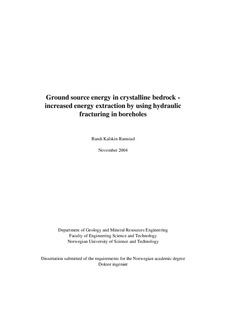| dc.description.abstract | The use of improved equipment and methodology can result in considerable reductions in the drilling costs for medium- to large sized ground source heat pump system in crystalline bedrock. The main point has been to use special techniques within hydraulic fracturing to create a larger heat exchange area in the bedrock, and thus a greater energy extraction per borehole. The energy extraction is based on circulating groundwater.
Stimulation with hydraulic fracturing is a well known technique in order to improve borehole yields for drinking water-, oil-, and geothermal purposes. A procedure for injection of propping agents in selected borehole sections, and custom-made equipment for hydraulic fracturing in crystalline bedrock, a double packer, have been developed in this study. The propping agents are likely to ensure a permanent improvement of the hydraulic conductivity in a long-run perspective.
In addition to a pre-test, a comprehensive test programme has been performed at each of the two pilot plants at Bryn and at the former property of Energiselskapet Asker og Bærum (EAB) in Bærum municipality outside Oslo, Norway. A total of 125 stimulations with hydraulic fracturing using water-only and hydraulic fracturing with injection of sand have been performed in 9 boreholes. Test pumping and geophysical logging (temperature, electrical conductivity, gamma radiation, optical televiewer and flow measurements) have been carried out in order to document the effect of the hydraulic fracturing.
The pilot plants at Bryn and EAB, where the ground source heat pump systems are based on circulating groundwater, have demonstrated the short-period energy extraction, limitations and opportunities of the concept for hydraulic fracturing and increased energy extraction in different geological and hydrogeological areas. The bedrock at Bryn and EAB is characterized as a low-metamorphic sandstone and a nodular limestone, respectively. At Bryn, the five boreholes were organised with a central borehole encircled by four satellite boreholes 13 metres away from the central borehole. The central borehole at EAB was flanked with two boreholes 16 and 20 metres away. In operation mode, groundwater was pumped from the satellite boreholes, heat exchanged, and re-injected into the groundwater magazine via the central borehole. Routine operation of the plants has not yet been initiated.
The main findings from this study can be summarized as follows:
•Hydraulic fracturing with water-only results in an overall increase in water yield for the hard rock borehole.
•Hydraulic fracturing with injection of sand as propping agent also leads to an increased water yield.
•The use of sand as propping agent seems to be more required in fractures with high counter pressure, in this study higher than approximately 40 bars, compared with fractures with lower counter pressure. The particle size of the sand should also be adjusted to the appearing counter pressure, and injection of coarser sand is recommended in fractures with lower counter pressures.
•Comparing the results from the hydraulic fracturing performed at Bryn and EAB shows that the pressure levels, required to create new fractures, varied considerably. The maximum pressures present at Bryn were higher than the corresponding pressures at EAB. At Bryn 70% (44 out of 63) of the pressure-time curves from the hydraulic fracturing with water-only were interpreted as initiation or reopening of fractures, while the number for EAB was 97% (36 out of 37). The lower degree of fracturing at Bryn is likely to be a result of high rock stresses and high tensile strength of the bedrock, also confirmed by the results from the rock stress measurements performed at Bryn. Considering the bedrock at EAB, characterized as nodular limestone, the tensile strength is assumed to be less than the values for the low-metamorphic sandstone present at Bryn.
•The infiltration rate in the central boreholes is a critical factor for the energy extraction and a successful operation of ground source heat pump systems based on circulating groundwater. Results from the short-period circulation tests accomplished at Bryn and EAB show that the infiltration rate in the central borehole at Bryn (approximately 2500 litres/hour) was too low to obtain a satisfactory operation of the plant, while the infiltration rate at EAB (14000 litres/hour) was sufficient to achieve profitability. Under the actual conditions, a reduction in the construction costs, i.e. the drilling costs, for a conventional ground source heat pump system with single U-collectors in vertical boreholes, of more than 50% were achieved for the pilot plant at EAB when the energy extraction from water is more than 105 MWh. The large difference in the infiltration rate between Bryn and EAB was probably related to: (1) Large initial differences in the borehole yield prior to hydraulic fracturing (<560 litres/hour at Bryn and >6300 litres/hour at EAB). Nodular limestone generally has high permeability, while compact sandstone rocks are expected to have low permeability. (2) Hydraulic fracturing was most successful at EAB. (3) The higher rock stress level present at Bryn compared to EAB will increase the tendency to tighten the opened fractures, even the fractures with injected sand •The FEFLOW-modelling of the pilot plant at Bryn and EAB emphasized the important relation between the available heat exchange area in the bedrock, the thermal conductivity of the bedrock, and the energy potential.
•The increased borehole yields achieved by hydraulic fracturing in this study, and the improved, reliable and cost-effective hydraulic fracturing techniques in crystalline bedrock, will probably increase the interest for groundwater as a domestic water supply for small- to medium sized water works. | nb_NO |
